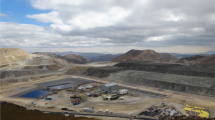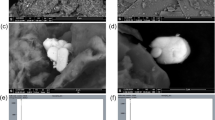Abstract
Elevated dissolved antimony (Sb) and arsenic (As) are common environmental issues around orogenic gold mines. The metalloids occur principally in stibnite (Sb2S3) and arsenopyrite (FeAsS), and are typically accompanied by pyrite (FeS2). Samples of arsenopyrite-rich (≈2.5 wt% As) and stibnite-rich (≈10 wt% Sb) ore were collected from the Globe-Progress mine in the Reefton goldfield, New Zealand. Crushed samples (<5 mm particles) were placed in kinetic leach columns and monitored for a year. Leachate was collected and analysed monthly. After 12 months, only a small portion (<1 %) of the total As and Sb had leached from the ore samples. Over the course of each month, the pH of all leachates decreased from ≈7 to ≈3 due to pyrite oxidation. Dissolution of Ca–Fe–Mg carbonates in the host rock was insufficient to neutralize the leachate. Dissolved As concentrations from the arsenopyrite-rich ore sample were initially 16 mg/L, but decreased to ≈2 mg/L over 12 months. Dissolved Sb concentrations from the stibnite-rich ore were >7 mg/L throughout the experimental period, with maxima of 12 mg/L. SEM analysis after 6 months showed secondary arsenolite (As2O3) and Ca–Al–Mg sulphates on arsenopyrite-rich ore surfaces, but an absence of secondary minerals, including Sb oxides, on stibnite-rich ore surfaces. These experiments document geochemical and mineralogical processes associated with short-term (days to weeks) water–rock interactions that yield relatively high concentrations of dissolved metalloids (>5 mg/L) where localised (1–10 m) acidification and limited oxidation occur in sulphide-rich rocks.
Zusammenfassung
Erhöhte Antimon- und Arsengehalte im Umfeld von orogenetisch gebildeten Goldlagerstätten sind im Normalfall bekannt. Die Halbmetalle kommen prinzipiell als Stibnit (Sb2S3) und Arsenopyrit (FeAsS) vor und sind typischerweise vergesellschaftet mit Pyrit (FeS2). Für die Experimente wurden Arsenopyrit-reiche (≈2.5 Gew. % As) und Stibnit-reiche (≈10 Gew. % Sb) Erze aus dem Globe-Progress Bergwerk im Reefton Goldbezirk, Neuseeland, verwendet. Gemahlene Proben (Korngröße < 5 mm) wurden in kinetischen Säulenversuchen ein Jahr lang untersucht. Die Lösungsanalytik fand monatlich statt. Nach 12 Monaten war erst ein geringer Anteil (< 1 %) des totalen As- bzw. Sb-Gehalts aus den Erzproben gelöst worden. Bedingt durch die Pyritoxidation sank der pH-Wert der Lösungen im Beobachtungszeitraum von ≈7 auf ≈3. Die Freisetzung von Ca-Fe-Mg-Karbonaten aus dem Ausgangsgestein war nicht ausreichend, um die Lösungen zu neutralisieren. Die anfänglich gelöste As-Konzentration von 16 mg/L aus den pyritreichen Erzproben gingen nach 12 Monaten auf Werte von ≈2 mg/L zurück. Die gelöste Sb-Konzentration der Stibnit-reichen Erzproben betrug > 7 mg/L, mit Maximalkonzentrationen von 12 mg/L. SEM-Analysen nach sechs Monaten zeigt die Bildung von sekundärem Arsenolith (As2O3) und von Ca-Al-Mg-Sulfat auf den Arsenopyrit-reichen Erzoberflächen. Auf den Stibnit-reichen Erzoberflächen wurde kein Sekundärmineral (auch kein Sb-Oxid) gefunden. Die Experimente dokumentieren geochemische und mineralogische Prozesse, welche durch kurzfristig wirksame Wasser-Gesteins-Wechselwirkungen (Tage/Wochen) hohe Austräge von gelösten Halbmetallen (> 5 mg/L) aus lokalen Versauerungsbereichen (1 - 10 m) begrenzen und Oxidationsprozesse in sulfidreichen Gesteinen limitieren.
Resumen
Elevadas disoluciones de antimonio (Sb) y arsénico (As) son problemas ambientales comunes asociados a las minas de oro orogénicas. Los metaloides se encuentran principalmente como estibnita (Sb2S3) y arsenopirita (FeAsS) y están usualmente acompañadas por pirita (FeS2). Muestras de minerales ricas en arsenopirita (≈2,5 % p/p As) y en estibnita (≈10 % p/p Sb) fueron colectadas en la mina Globe-Progress en la región minera Reefton, Nueva Zelanda. Muestras molidas (partículas <5 mm) se colocaron en columnas de lixiviación y fueron monitoreadas por un año. Los lixiviados fueron colectados y analizados mensualmente. Después de 12 meses, sólo una pequeña porción (<1%) del total de As y Sb había sido lixiviado desde las muestras. En el curso de cada mes, el pH de todos los lixiviados decreció desde ≈7 a ≈3 debido a la oxidación de pirita. La disolución de carbonatos de Ca-Fe-Mg fue insuficiente para neutralizar el lixiviado. La concentración de As disuelto desde la muestra rica en arsenopirita fue inicialmente 16 mg/L, pero decreció hasta ≈2 mg/L a los 12 meses. La concentración de Sb disuelto desde la muestra rica en estibnita fue >7 mg/L a lo largo del experimento con un valor máximo de 12 mg/L. El análisis SEM después de seis meses mostró arsenolita (As2O3) y sulfatos de Ca-Al-Mg sobre las superficies ricas en arsenopirita pero una ausencia de minerales secundarios, incluyendo óxidos de Sb, sobre las muestras ricas en estibnita. Estos experimentos documentan los procesos geoquímicos y mineralógicos asociados con las interacciones de corto plazo (días a semanas) entre roca y agua que dan relativamente altas concentraciones de metaloides disueltos (>5 mg/L) donde localizada (1-10 m) acidificación y limitada oxidación ocurren en rocas ricas en sulfuros.
摘要
溶解态锑(Sb)和砷(As)浓度的升高是造山带型金矿附近最常见的水环境问题。准金属主要赋存于辉锑矿(Sb2S3)和砷黄铁矿(FeAsS)中,并为黄铁矿(FeS2)所伴生。富含砷黄铁矿(As的质量分数为2.5%)和辉锑矿(Sb的质量分数为10%)矿石样品取自新西兰雷夫顿金矿带(Reefton goldfield)的Globe-Progres矿。矿石被粉碎后(颗径<5mm)放置于淋滤柱中进行为期一年的动态淋滤实验。每月集取并分析淋滤液一次。在试验12个月之后,仅有一小部分(<1%)的砷(As)和锑(Sb)被淋滤出来。在淋滤过程中,黄铁矿的氧化作用使淋滤液的pH值由7左右降到了3左右。淋滤试验母岩中Ca-Fe-Mg碳酸盐溶液不足以中和淋滤液的酸性。富砷黄铁矿样品淋滤液中砷(As)浓度最初为16mg/L,在12个月后降到约2mg/L。富辉锑矿样品淋滤液的锑(Sb)浓度在实验期间均大于7mg/L,最大浓度曾达12mg/L。淋滤试验六个月之后的电子显微镜扫描(SEM)显示,富砷黄铁矿矿石表面有次生砷华(As2O3)和Ca-Al-Mg硫酸盐生成,但富辉锑矿矿石表面却未见锑(Sb)氧化物等次生矿物。实验记录了矿石样品水-岩之间的短期(数日至数周)地球化学和矿物学过程,证明由于富含硫化物岩石表面的局部(1-10m)酸化及氧化作用产生了高浓度的溶解态类金属(>5 mg/L)。











Similar content being viewed by others
References
Alpers CN, Blowes DW, Nordstrom DK, Jambor JL (1994) Secondary minerals and acid mine-water chemistry. In: Jambor JL, Blowes DW (eds), Environmental Geochemistry of Sulfide Mine Wastes, Mineralogical Assoc of Canada Short Course Handbook 22:247–270
APHA (1998) Standard methods for the examination of water and wastewater, 20th edn. American Public Health Association, Washington
APHA (2005) Standard methods for the examination of water and wastewater, 21st edn. American Public Health Association, Washington
Ashley RP (2002) Geoenvironmental model for low-sulfide gold-quartz veins. In: Seal II RR, Foley NK (eds) Chapter K, progress on geoenvironmental models for selected mineral deposit types, USGS Open File Report 02-195, Reston, VA, USA, pp 176–195
Ashley PM, Craw D, Graham BP, Chappell DA (2003) Environmental mobility of antimony around mesothermal stibnite deposits, New South Wales, Australia and southern New Zealand. J Geochem Explor 77:1–14
Bierlein FP, Christie AB, Smith PK (2004) A comparison of orogenic gold mineralisation in central Victoria (AUS), western South Island (NZ) and Nova Scotia (CAN): implications for variations in the endowment of Palaeozoic metamorphic terrains. Ore Geol Rev 25:125–168
Biver M, Shotyk W (2012) Stibnite (Sb2S3) oxidative dissolution kinetics from pH 1 to 11. Geochim Cosmochim Acta 79:127–139
Bluteau MC, Demopoulos GP (2007) The incongruent dissolution of scorodite—solubility, kinetics and mechanism. Hydrometallurgy 87:163–177
Christie AB, Brathwaite RL (2003) Hydrothermal alteration in metasedimentary rock-hosted orogenic gold deposits, Reefton goldfield, South Island, New Zealand. Miner Depos 38:87–107
Cooper RA (1974) Age of the Greenland and Waiuta Groups, South Island, New Zealand. NZ J Geol Geophys 17:955–962
Craw D (2001) Tectonic controls on gold deposits and their environmental impact, New Zealand. J Geochem Explor 73:43–56
Craw D, Wilson N, Ashley PM (2004) Geochemical controls on the environmental mobility of Sb and As at mesothermal antimony and gold deposits. Trans Inst Min Metall B 113:3–10
Desbarats AJ, Parsons MB, Percival JB, Beauchemin S, Kwong YT (2011) Geochemistry of mine waters draining a low-sulfide, gold-quartz vein deposit, Bralorne, British Columbia. Appl Geochem 26:1990–2003
Druzbicka J, Craw D (2013) Evolving metalloid signature in waters draining from a mined orogenic gold deposit, New Zealand. Appl Geochem 31:251–264
EPA (2007) Field portable X-ray fluorescence spectrometry for the determination of elemental concentrations in soil and sediment, Method 6200. Technical report SW-846, US Environmental Protection Agency, Washington, DC, USA
Filella M, Philippo S, Belzile N, Chen Y, Quentel F (2009) Natural attenuation processes applying to antimony: a study in the abandoned antimony mine in Goesdorf, Luxembourg. Sci Total Environ 407:6205–6216
Goldfarb RJ, Taylor CD, Meier AL, d’Angelo WM, O’Leary RM (1995) Hydrochemistry of mine-drainage waters associated with low-sulphide, gold-quartz veins in Alaska. In: Dumoulin JA, Gray JE (eds) Geologic studies in Alaska by the U.S. Geological Survey. USGS Professional Paper 1574, Washington, DC, USA, pp 3–17
Haffert L, Craw D (2008) Mineralogical controls on environmental mobility of arsenic from historic mine processing residues, New Zealand. Appl Geochem 23:1467–1483
Haffert L, Craw D, Pope J (2010a) Climatic and compositional controls on secondary arsenic mineral formation in high-arsenic mine wastes, South Island, New Zealand. NZ J Geol Geophys 53:91–101
Haffert L, Sander SG, Hunter KA, Craw D (2010b) Evidence for arsenic-driven redox chemistry in a wetland system: a field voltammetric study. Environ Chem 7:386–397
Hewlett L, Craw D, Black A (2005) Comparison of arsenic and trace metal contents of discharges from adjacent coal and gold mines, Reefton, New Zealand. Mar Freshw Res 56:983–995
Johnson DL, Pilson MEQ (1971) Spectrophotometric determination of arsenite, arsenate, and phosphate in natural waters. Anal Chim Acta 58:289–299
Krause E, Ettel VA (1988) Solubilities and stabilities of ferric arsenate compounds. Hydrometallurgy 22:311–337
Langmuir D (1997) Aqueous environmental geochemistry. Prentice Hall, Upper Saddle River
Langmuir D, Mahoney J, Rowson J (2006) Solubility products of amorphous ferric arsenate and crystalline scorodite (FeAsO4·2H2O) and their application to arsenic behaviour in buried mine tailings. Geochim Cosmochim Acta 70:2942–2956
Lottermoser BG (2007) Mine wastes: characterization, treatment and environmental impacts, 2nd edn. Springer, Berlin
Milham L, Craw D (2009a) Antimony mobilisation through two contrasting gold ore processing systems, New Zealand. Mine Water Environ 28:136–145
Milham L, Craw D (2009b) Two-stage structural development of a Paleozoic auriferous shear zone at the Globe-Progress deposit, Reefton, New Zealand. NZ J Geol Geophys 52:247–259
Oxford Instruments (2015) Silicon Drift Detector (SDD)—X-MaxN. Oxford Instruments. http://www.oxford-instruments.com/products/microanalysis/energy-dispersive-x-ray-systems-eds-edx/eds-for-sem/sdd. Accessed 6 Jan 2015
Paktunc D, Bruggeman K (2010) Solubility of nanocrystalline scorodite and amorphous ferric arsenate: implications for stabilization of arsenic in mine wastes. Appl Geochem 25:674–683
Paktunc D, Dutrizac J, Gertsman V (2008) Synthesis and phase transformations involving scorodite, ferric arsenate and arsenical ferrihydrite: implications for arsenic mobility. Geochim Cosmochim Acta 72:2649–2672
Plumlee GS (1999) The environmental geology of mineral deposits. In: Plumlee GS, Logsdon MJ (eds) The environmental geochemistry of mineral deposits, Part A, processes, techniques and health issues, Rev Econ Geol 6A:71–116
Plumlee GS, Smith KS, Montour MR, Ficklin WH, Mosier EL (1999) The environmental geology of mineral deposits. In: Filipek LH, Plumlee GS (eds) The environmental geochemistry of mineral deposits, Part B, case studies and research topics, Rev Econ Geol 6B:71–116
Pokrovski G, Gout R, Zotov A, Schott J, Harrichoury JC (1996) Thermodynamic properties and stoichiometry of the As(III) hydroxide complexes at hydrothermal conditions. Geochim Cosmochim Acta 60:737
Pope J, Weber P, Mackenzie A, Newman N, Rait R (2010) Correlation of acid base accounting characteristics with the geology of commonly mined coal measures, West Coast and Southland, New Zealand. NZ J Geol Geophys 53(2–3):153–166
Rattenbury MS, Stewart M (2000) The structural setting of the Globe-Progress and Blackwater gold mines, Reefton Goldfield, New Zealand. NZ J Geol Geophys 43:435–445
Seal RR, Hammarstrom JM (2003) Geoenvironmental models of mineral deposits: examples from massive sulfide and gold deposits. In: Jambor JL, Blowes DW, Ritchie AIM (eds) Environmental aspects of mine wastes, Mineralogical Assoc of Canada Short Course 31:11–50
Smart R, Skinner WM et al (2002) ARD test handbook: project P387A prediction and kinetic control of acid mine drainage. AMIRA International Ltd, Melbourne
Vink B (1996) Stability relations of antimony and arsenic compounds in the light of revised and extended Eh-pH diagrams. Chem Geol 130:21–30
Waychunas GA, Fuller CC, Rea BA, Davis JA (1996) Wide-angle X-ray scattering (WAXS) study of “two-line” ferrihydrite structure: effect of arsenate sorption and counterion variation and comparison with EXAFS results. Geochim Cosmochim Acta 60:1765–1781
Wilson NJ, Craw D, Hunter K (2004) Contributions of discharges from a historic antimony mine to metalloid content of river waters, Marlborough, New Zealand. J Geochem Explor 84:127–139
Winterbourn MJ, McDiffett WF (1996) Benthic faunas of streams of low pH but contrasting water chemistry in New Zealand. Hydrobiologia 341:101–111
Acknowledgments
This research was supported by the Ministry of Science and Innovation, and additional funding was provided by the University of Otago. Kat Lilly expertly produced the SEM images. We are grateful to Oceana Gold Ltd, especially John Bywater, for ongoing support of this research, and access to monitoring data and the mine site for collection of the experimental materials. Joanna Druzbicka provided data and helpful discussions. Able and efficient technical assistance with the leaching experiments was provided by Helen Rogers and Meng Shi at CRL Energy in Christchurch. Constructive comments by two anonymous referees substantially improved the paper.
Author information
Authors and Affiliations
Corresponding author
Electronic supplementary material
Below is the link to the electronic supplementary material.
Rights and permissions
About this article
Cite this article
Kerr, G., Pope, J., Trumm, D. et al. Experimental Metalloid Mobilisation from a New Zealand Orogenic Gold Deposit. Mine Water Environ 34, 404–416 (2015). https://doi.org/10.1007/s10230-015-0332-x
Received:
Accepted:
Published:
Issue Date:
DOI: https://doi.org/10.1007/s10230-015-0332-x




